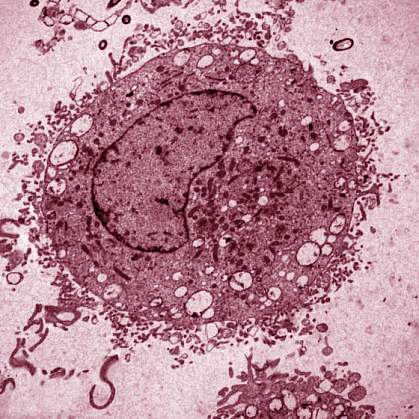You are here
January 26, 2015
Researchers Link Protein to Drug Allergies
At a Glance
- Scientists identified a protein in human immune cells responsible for certain drug-induced allergic reactions.
- Blocking the action of this protein may lessen the side effects of many commonly used medications.

Tens of millions of people in the United States suffer from some sort of allergy. Allergies occur when the immune system reacts to the presence of an otherwise harmless substance. In some cases, exposure to an allergen can cause anaphylaxis—a severe, sometimes deadly allergic reaction that may cause difficulty breathing and swallowing.
Immune cells known as mast cells play a primary role in allergic reactions. Mast cells are activated by immunoglobulin E (IgE) antibodies and release inflammatory chemicals like histamine. Some compounds, however, can activate mast cells without interacting with IgE antibodies, triggering a so-called “pseudo-allergic” reaction. These substances, known as basic secretagogues, include many drugs that can cause allergic reactions. While the symptoms of a pseudo-allergic reaction may resemble those of a normal allergic reaction, the lack of antibody involvement suggests that they occur through a separate mechanism.
A team of researchers led by Drs. Benjamin McNeil and Xinzhong Dong at Johns Hopkins University explored the mechanism of pseudo-allergic drug reactions. Their study, which was funded in part by NIH’s National Institute of Neurological Disorders and Stroke (NINDS) and National Institute of General Medical Sciences (NIGMS), was published online on December 17, 2014, in Nature.
Basic secretagogues were thought to activate human mast cells by binding to a protein receptor known as MRGPRX2. The complex genetics of the equivalent mouse receptor, however, made studying the receptor technically difficult. The research team developed a knockout mouse model that allowed them to study the receptor in depth.
The scientists determined that Mrgprb2 receptors are found in the mast cells of mice and that compounds that activate human MRGPRX2 receptors, including basic secretagogues, also activate the mouse receptors.
The researchers created mice with Mrgprb2 receptors that weren’t functional. These mice had normal numbers of mast cells, and the mast cells were triggered normally by IgE antibodies. However, basic secretagogues and certain drugs known to cause allergic reactions in humans didn’t cause such reactions in the mutant mice. The compounds also failed to activate lab-grown mouse mast cells lacking the Mrgprb2 receptor and human mast cells lacking the MRGPRX2 receptor. These results confirm that the receptors are responsible for pseudo-allergic reactions.
“It’s fortunate that all of the drugs turn out to trigger a single receptor—it makes that receptor an attractive drug target,” McNeil says.
The researchers are now investigating compounds that block the action of the receptor. Such drugs could potentially prevent adverse reactions to many commonly used medications.
—by Brandon Levy
Related Links
References: Identification of a mast-cell-specific receptor crucial for pseudo-allergic drug reactions. McNeil BD, Pundir P, Meeker S, Han L, Undem BJ, Kulka M, Dong X. Nature. 2014 Dec 17. pii: 2014022. [Epub ahead of print]. PMID: 25517090.
Funding: NIH’s National Institute of Neurological Disorders and Stroke (NINDS) and National Institute of General Medical Sciences (NIGMS); and the Howard Hughes Medical Institute.
